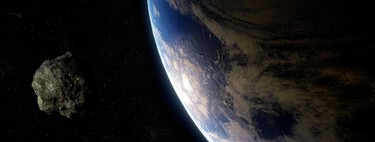While we await the results of its impact, the DART mission has left us with a surprising image. It has been captured from Earth, from a Chilean telescope. The image shows the Didymos asteroid system with a mile-long dust tail that makes it look like a comet.
A feather of 10,000 kilometers.
The recently posted image by the National Optical-Infrared Astronomy Research Laboratory (NOIRLab) shows the effects of the impact of the DART probe on the asteroid Dimorphos, part of the binary system Didymos. The Didymos is formed by an asteroid of the same name, about 800 meters in diameter, orbited by an asteroid-satellite, Dimorphos, barely 160 meters long.
Although Dimorphos’s orbit is slightly more than a kilometer away from Dimorphos (that is, the entire system occupies no more than a kilometer and a half radius), the “plume” of dust and rock that kicked up the blow extends for more than 10,000 kilometers.
Like the tail of a comet.
The image was captured two days after the impact. The cloud of dust and rocks expelled by the impact has been shaped not only by the force of the impact itself but also by the pressure exerted by solar radiation, in a way similar to that which occurs with the tail of comets, clouds of matter that always “point” away from our star.
“It is fascinating how clearly we are able to capture the structure and extent of the consequences [del impacto] in the following days” he explained. in a press release Teddy Kareta, one of those in charge of taking the image.
The kamikaze probe.
The DART probe (acronym for Double Asteroid Redirection Test) crashed in the early hours of September 27 against the smallest of the asteroids in the Didymos system, Dimorphos. The purpose was to provide it with enough kinetic energy to deflect it slightly in order to test our abilities to avoid the impact of a rock with similar characteristics if it were to go to Earth.
The first part of the mission, crashing the probe into the asteroid, was a success, but the effect of the hit on the trajectory that Dimorphos traces around Didymos has yet to be measured.
Experts believe that, by analyzing the effect of the shock, it is possible to generate precise models that allow us to calculate how we should hit a hypothetical asteroid headed for Earth, based on its previous trajectory, speed and composition.
Analysis from various angles.
It is observations like these that should allow astronomers to calculate the effect of the DART mission on the asteroid’s orbit, to what extent it has been altered and how we can extrapolate this data when we go to deflect the one that could be heading towards us.
The data that the DART team will work with not only includes information about Dimorphos’s new speed and trajectory, but also about this cloud of dust and rocks that is no longer part of the asteroid. This will make it easier to understand, for example, to what extent the rock that makes up the object was in a compact state.
SOAR.
The image was captured from the SOAR telescope (Southern Astrophysical Research), a 4.1-meter telescope located on Cerro Pachón, in the Chilean Andes. It is located 2,713 meters above sea level and was opened in 2006.
In its surroundings you can find various astronomical observatories such as CTIO (Cerro Tololo Inter-American Observatory) and the Gemini South telescope. This concentration of telescopes in the Andean mountains is not accidental, it is due to the combination of several factors, such as its relative isolation and its altitude.
Telescopes in the area such as the Vera C. Rubin will also be some of those in charge of searching our environment for asteroids and objects that could pose a threat to our existence on this planet.
Image | CTIO/NOIRLab/SOAR/NSF/AURA/T. Kareta (Lowell Observatory), M. Knight (US Naval Academy), CC BY 4.0
Processed by | TA Rector (University of Alaska Anchorage/NSF’s NOIRLab), M. Zamani & D. de Martin (NSF’s NOIRLab)




![[Img #74661]](https://thelatestnews.world/wp-content/uploads/2024/12/The-power-of-ultrasound-150x150.jpg)








![[Img #74661]](https://thelatestnews.world/wp-content/uploads/2024/12/The-power-of-ultrasound-300x200.jpg)

